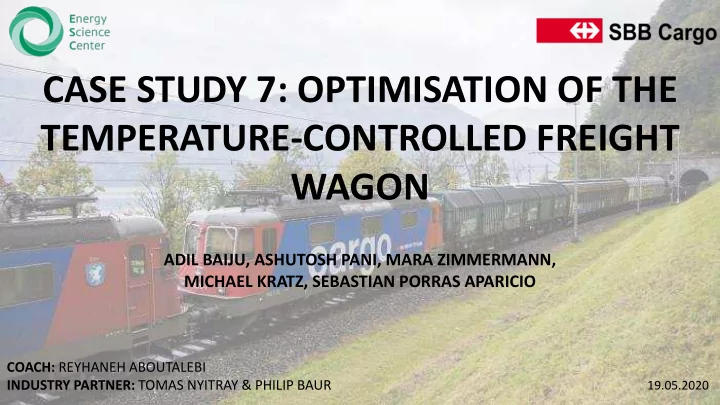

CASE STUDY 7: OPTIMISATION OF THE TEMPERATURE-CONTROLLED FREIGHT WAGON ADIL BAIJU, ASHUTOSH PANI, MARA ZIMMERMANN, MICHAEL KRATZ, SEBASTIAN PORRAS APARICIO COACH: REYHANEH ABOUTALEBI INDUSTRY PARTNER: TOMAS NYITRAY & PHILIP BAUR 19.05.2020
PRESENTATION AGENDA 1.PROBLEM FORMULATION 2.COOLING LOADS 3.MODELLING 4.RESULTS & DISCUSSION 5.CONCLUSIONS
PROBLEM FORMULATION OPTIMISED HVAC OPTIMISED LCC
PROBLEM FORMULATION MULTI-OBJECTIVE OPTIMISED HVAC OPTIMISATION MODEL OPTIMISED LCC
COOLING LOADS Deep Freeze Wagon Cooling Wagon -18 ° C +4 ° C
COOLING LOADS Deep Freeze Wagon Cooling Wagon -18 ° C +4 ° C Transmission load Equipment Load Internal Load Product Load Infiltration Load
COOLING LOADS Deep Freeze Wagon Cooling Wagon -18 ° C +4 ° C Transmission load Equipment Load Internal Load Product Load Infiltration Load
COOLING LOADS Deep Freeze Wagon Cooling Wagon -18 ° C +4 ° C Transmission load Equipment Load Internal Load Product Load Infiltration Load
COOLING COOLING COOLING LOADS LOADS LOADS Deep Freeze Wagon Deep Freeze Wagon Deep Freeze Wagon Cooling Wagon Cooling Wagon Cooling Wagon -18 ° C -18 ° C -18 ° C +4 ° C +4 ° C +4 ° C Safety Factor: 10%
OPTIMISATION MODEL • Two objectives → pareto front • CO 2 -emissions: diesel and electricity demand • LCC: investment, fuel cost, O&M over lifetime of 10 years • Decisions: • Outside wall dimensions • Insulation: PU, VIP and Divinycell • Cooling component
RESULTS & DISCUSSION Figure 1: (a) Cross-section of the wagon with optimised dimensions for Figure 2: Pareto optimal results for the multi-objective optimisation for total costs and CO 2 minimum costs (b) Loading scheme for 42 Euro-pallets emissions for the deep freeze wagon.
RESULTS & DISCUSSION Figure 3: Summary of the different costs and diesel consumption of the recommended, the minimum cost and the PU-only technology setup for the deep freeze wagon
RESULTS & DISCUSSION SPECIFICATION RECOMMENDED MINIMUM COST PU-ONLY SIDE WALLS 25 15 0 DOORS 45 25 0 BACK WALLS 0 0 0 ROOF 1 45 15 0 ROOF 2 0 0 0 ROOF 3 0 0 0 COOLING UNIT TK SLXi-400 TK SLXi-400 TK SLXi-400 Table 1: Summary of VIP thicknesses of the recommended, the minimum cost and the PU-only technology setup for the deep freeze wagon
RESULTS & DISCUSSION Figure 4: Pareto optimal results for the multi-objective optimisation for total costs and Figure 5: Summary of the different costs and diesel consumption of the technology setup CO 2 emissions for the deep freeze wagon with only 110 working days for the deep freeze wagon with only 110 working days per year.
RESULTS & DISCUSSION Figure 6: Comparison of the total U-values for the recommended, the VIP-only and the PU-only setup of the deep freeze wagon.
RESULTS & DISCUSSION Figure 7: Pareto optimal results for the multi-objective optimisation for total costs and Figure 8: Summary of different costs and diesel consumption of the technology setup for CO 2 emissions for the deep freeze wagon with only 110 working days the cooling wagon
RESULTS & DISCUSSION ITEM OLD WAGON PROPOSED WAGON DIFFERENCE OPERATION COSTS (CHF/EUR-PALLET) 2,520 993 -60.6% CO 2 EMISSIONS (TON/EUR-PALLET) 4.89 1.87 -61.8% DIESEL CONSUMPTION (LITRE/EUR- 180,080 68,595 -61.9% PALLET) Table 2: Comparison of performance and cost values between proposed deep freeze wagon and the old SBB Cargo wagon model Hbbills-uy
CONCLUSIONS • VIP panels represent a valuable option in reducing LCC and CO 2 emissions • Most effective insulation system depends on air channels • Optimised side wall dimensions lead to an improved U-value • Insulation materials should be analysed per wagon section
THANK YOU FOR YOUR ATTENTION
REFERENCES • Cover - https://fortune.com/2015/10/06/bosch-smart-trains/ • Wagon - https://www.kdylogistics.com/en/reilcar-fleet-en/ • Verma, S. and Singh, H. Vacuum insulation in cold chain equipment: A review.Energy Procedia,161, 232 – 241, 2019. • Beers, A. A., Smith, S. W., Crisafulli, C., Richmond, S. and Cribbs, R. A.Temperature controlled railway car, U.S. Patent US7478600B2, 2009 • Tassou, S., De-Lille, G. and Ge, Y. Food transport refrigeration – Approachesto reduce energy consumption and environmental impacts of road transport.Applied Thermal Engineering,29, 1467 – 1477, 2009 • Thermal Insulation Association of Southern Africa (TIASA).Thermal Insula-tion Handbook. 2001. • Chatzidakis, S. K. and Chatzidakis, K. S. Refrigerated transport and environ-ment.International Journal of Energy Research,28(10), 887 – 897, 2004.
Recommend
More recommend